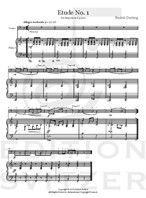
5 Etudes for Timpani and Piano (vol. 1)
Composer: Fredrik Duvling
Instrument: Timpani and Piano
Level: Intermediate
Published: 2015
Price: €16.00
Item details
-
Description +
-
Duration: 10 min.
5 Etudes for Timpani and Piano (using 4 timpani with dimensions 23”, 26", 29 "and 32".)
My idea with these five etudes are different types of solutions to problems. In Etude No. 2 and 4 the focus is on shifting tones with pedals with middle timpani. In Etude No. 1 the focus is on shifting tones with pedals with outer timpani. In Etude No. 3 and 5 it is three timpani as shifting tones with pedals.
When playing the timpani is not only about playing rhythmically like all the other percussion instruments. It´s also about to be responsive and be able to intonate together with other instruments in the orchestra or as in these etudes with the piano.
Initially I had thought about writing etudes for solo timpani entirely, but the idea of making a piano accompaniment was simply to have something to "relate to", and when you have pause in the music and possibly have to adjust the intonation if needed.
There are many types of timpani techniques, how to hold the sticks etc. But often forgets about the pedals and use the feet, to be able to use them when playing the timpani. To be as technically perfect and to change tones and be sure about the intervals and to "feel" with your feet where the tones are. To constantly think ahead what comes next in the score, and to prepare for preparations in time and be able to perform these even during of playing.
I haven’t entered any kind of dampening of the timpani, but the idea is that one has to feel free and phrase by own potential. Try to play as clear and distinct that the tones doesn’t ring into each other too much when you have the chance and opportunity to damp. But it shouldn’t be exaggerated so the music or timing gets lost.
In the various etudes, I mixed a little so the timpani have slightly different roles such as thinking the part as a solo part, singable where you can phrase the melody in a clear and natural way, while in some etudes it´s more a form of accompaniment role.
I haven´t proposed any suggestions of timpani mallets but leaves it entirely to the performer to independently create and make music in his/her own way and by heart.
Fredrik Duvling
-
-
Instrumentation +
-
Timpani and Piano
-
-
About the composer +
-
Fredrik Duvling (b. 1972) percussionist, lives in Gothenburg, Sweden. He has been working as a freelance musician since 1994, both in orchestras and as a chamber musician. He also teaches percussion at the Academy of Music in Örebro and at the Ljungskile Pre-University Music School in Sweden.
He is educated at the Music Academy in Gothenburg for professor Einar Nielsen and Bo Holmstrand, a former percussionist of the Gothenburg Symphony Orchestra. Studies also has been done for the percussionist/professor Gert Mortensen in Copenhagen. Fredrik were contracted between 1998-2003 in the Royal Danish Orchestra in Copenhagen and has since then freelanced in Scandinavia among the orchestras. In addition to that since 1992 together with the marimbaplayer Daniel Berg, Fredrik plays in the percussionduo Rhythm Art Duo. Credits
-
-
Reviews +
-
Review (Percussive Notes, July 2016)
Fredrik Duvling’s “Five Etudes for Timpani and Piano” are a great addition to the timpani repertoire. With varied tempos and time signatures, each etude is technically centered around choreographing footwork to shift pitches on different two- or three-drum combinations. These etudes are more than just pedaling and tuning exercises, though; they also introduce the timpanist to various styles, including a waltz, a 6/8 march, fast twoand four-beat pieces, and a slow, more lyrical etude. The etudes require legato and staccato strokes, and they utilize multiple tonal centers. The composer has intentionally left dampening and stick choice up to the performer.
The most unique aspect of this set of etudes is that, rather than the more traditional soloist and accompanist roles, the timpanist and pianist are clearly duet partners. This challenges the timpanist to develop an ear for playing with an accompanist and also being an accompanist, as well as playing equal roles. In short, these are not just etudes; they are thoughtful, fun, and complex pieces of music that are also appropriate to perform as a set on an undergraduate recital.
—Julie Licata
-
-
Credits +
-
Front Cover graphics and layout: Gaia Gomes
Engraving: Johan Svitzer
Photo: Per Buhre
Printed in Copenhagen, Denmark
Copyright © Edition SVITZER
www.editionsvitzer.com
-

